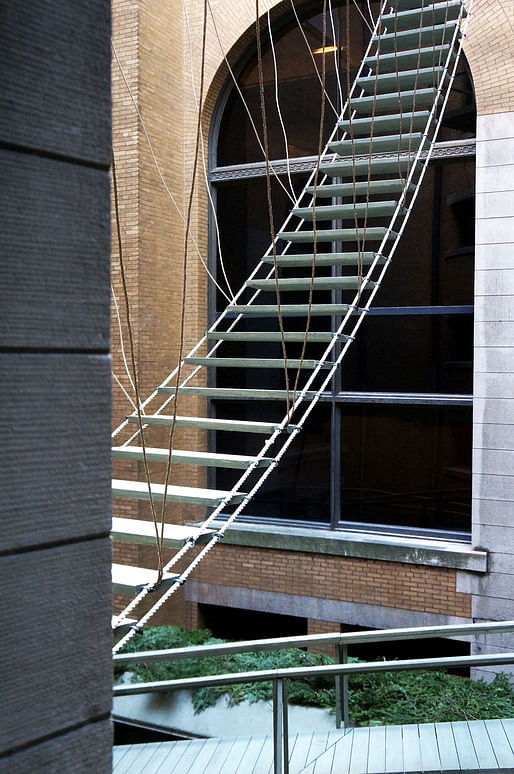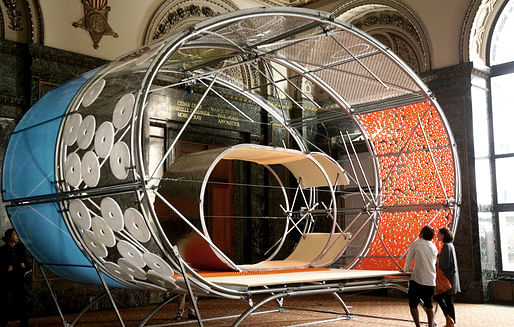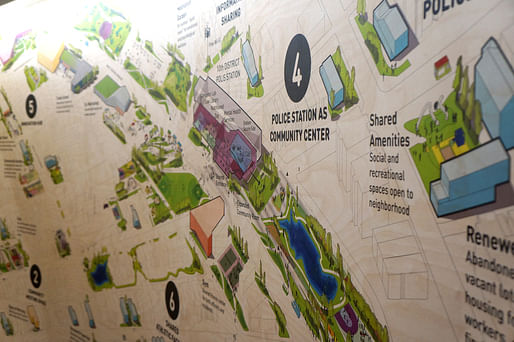
May '13 - Dec '15
The Chicago Architecture Biennial is an unbelievably rich, dense, colorful survey of architectural thought all over the globe. Everything from paper collages to massive urban revitalization projects are represented, and the ideas and conversations being had sparkle with excitement. Excitement...and, sometimes, the way the architects describe their own work is just a little too distant from how it actually plays out in the real world. Below are a selection of projects with two descriptions each: how the architects described them, and the too-long-didn't-read (TL;DR) synopsis.
(warning: some adult language ahead)
Sou Fujumoto, Architecture Is Everywhere; image credit Jessica A.S. Letaw
Architecture is Everywhere
Sou Fujimoto: "Architecture is first found and then made. Just as our ancestors found their habitat in caves and woods, we discover ours among the many things we encounter in the immense urban jungle. The notion of "found architecture" is represented by juxtaposing human figures and ordinary objects found in everyday life with contexts that might seem coincidental at first, if not fortuitous. This operation makes us start to read these objects as architectural spaces. While we might find these serendipitous pairings interesting for their discrepancy in scale, what lies beyond them might well be the prelude to a new architecture. Fujimoto's approach can be traced back to Marcel Duchamp's readymades or John Cage's series of chance operations - specifically, the act of discovering by chance rather than creating with intent. Architecture Is Everywhere aims to radically question the boundary between "found" and "made" architecture."
TL;DR: "I AM THE KING OF INSTAGRAM"
Bureau Spectacular, Furniture Urbanism; photo credit Jessica A.S. Letaw
Furniture Urbanism
Bureau Spectacular: "In a domestic environment, the scattering of objects imposes order within a house. This type of urbanism creates micro-zones that we understand as programs – the kitchen, the bedroom, the living room, and so forth. Furniture Urbanism explores a lack of flexibility in an overcrowded environment."
TL;DR: "sh*t Angeleno architects say"
Smout Allen + Geoff Manaugh, LA Recalculated; photo credit Jessica A.S. Letaw
L.A. Recalculated
Smout Allen + Geoff Manaugh: "21st century Los Angeles has inadvertently fulfilled Lebbeus Woods’ speculative vision of a hypothetical city shaped by seismic events. This permanent flux and lack of anchorage makes Los Angeles bathymetric, rather than terrestrial. LA Recalculated is a cartographic drawing – part map, part plan, part deep section – documenting the city as an archipelago of scientific instruments realized at the scale of urban infrastructure."
TL;DR: "L.A. has earthquakes and we hate it"
Didier Faustino, BUILTHEFIGHT; photo credit DesignApplause
BUILTHEFIGHT
Didier Faustino: "In the wake of Occupy Wall Street and other protest movements all over the world, Didier Faustino proposes a modular architecture designed to structure protest sit-ins. The aesthetic of the project also refers, paradoxically, to the design of anti-riot police equipment and chain-link fences. This duality places the demonstrator in a double condition: offensive and defensive. The prototype proposes a political “architecture-event,” designed to enable defensive formations."
TL;DR: "we're pretending that architecture is for the 99%"
Atelier Bow-Wow, Piranesi Circus; photo credit Jessica A.S. Letaw
Piranesi Circus
Atelier Bow-Wow: "The courtyard of the Chicago Cultural Center is inaccessible, even though it is visible from all sides of the building. This relationship of secludedness enhances the perception of the courtyard as a void in the middle of the building. The proposition of bringing people into the courtyard presents several difficulties - not environmental or physical concerns but rather issues with security, safety, and facility management. In this sense, the void is actually a space governed by the functional rules of everyday life. By introducing several suspended elements for movement and circulation, the courtyard is transformed into a marriage between an imaginary prison and a circus. A series of ramps, starting from the bottom of the courtyard, leads to one of the arched windows, with several benches along the way offering a privileged viewpoint from which visits can look up and observe the scenario above. A long ladder learning against the western façade provides imaginary access to the roof. A suspended bridge visually extends the vertical path of the stairs out into the courtyard. As the immovable glass of the window negates access from within, the stairway continues further up, finding its way out to the roof. A cantilevered balcony extending from another window becomes an occasional point of access to a swing, suspended above the courtyard. The ramp, ladder, suspended bridge, cantilevered balcony, and swing are not accessible to the general public but are rather for the use of circus performers - or for imaginary prisoners."
TL;DR: "This way, Griffindors"
Tomas Saraceno, Spiders; photo credit Jessica A.S. Letaw
Spiders
Tomas Saraceno: Entering into the installation, the visitor’s senses must reorient to a darkened environment dotted with glowing sculptures articulated in silvery spider silk. Formed of complex interwoven geometries suspended in air, each appears as a unique galaxy floating within an expansive, infinite landscape. (Actual spiders not included in the installation.)
TL;DR: "Ooooh...ewwww."
Johnston Marklee, A House is a House is a House is a House; photo credit Jessica A.S. Letaw
A House is a House is a House is a House
Johnston Marklee: "Outsiders’ points of view on architecture often reveal latent elements so powerful that they shift the architects’ own understanding of the work. In Johnston Marklee’s projects of artist spaces, this process of feedback between artist and architect often interrogates the architectural form beyond its original dimension. This spirit of collaboration has yielded a series of images produced by artists, inspired by or depicting the firm’s built projects."
TL;DR: "We hung an entire wall of selfies"
Gramazio Kohler Research + MIT's Self-Assembly Lab, Rock Print; photo credit Jessica A.S. Letaw
Rock Print
Gramazio Kohler Research and MIT’s Self-Assembly Lab: "The first architectural construction built by robotic machines using only rocks and thread, without any adhesive or mortar, Rock Print is a collaborative installation by Gramazio Kohler Research and MIT’s Self-Assembly Lab. This load-bearing column (tested up to three tons) goes far beyond manual-assembly techniques of drystone walls, presenting a unique combination of state-of-the-art knowledge from architecture, digital fabrication, and material science."
TL;DR: "we built a lumpy sandcastle with a robot"
RAAAF, The End Of Sitting-Cut Out; photo credit Jessica A.S. Letaw
The End of Sitting-Cut Out
RAAAF: "The End of Sitting-Cut Out is an installation at the crossroads of architecture, visual art, and philosophy. In our society, the near entirety of our surrounds has been designed for sitting, but evidence from medical research suggests that sitting for too long is unhealthy. RAAAF has developed a concept wherein the chair and desk are no longer unquestionable starting points. Instead, the installation's various "affordances" (possibilities of action) solicit visitors to explore different positions from that iteration and to move dynamically in an experimental working landscape. The End of Sitting-Cut Out marks the beginning of an experimental trial phase, exploring the possibilities for a radical change in the way we will work in offices in 2025."
TL;DR: "white people vogueing awkwardly"
OtherOthers, Offset House; photo credit Tom Harris courtesy Chicago Architecture Biennial
Offset House
OtherOthers: "While Australian architecture is associated with bespoke pavilions in idyllic wilderness settings, mass-produced suburban housing is the norm. Australians have the largest average home sizes and living spaces of any nation; 24 million people occupy an area larger than the continental U.S. Australia is both one of the world’s most urbanized nations and among the least dense. The country’s interior is sparsely populated, and fewer than 10% of Australians live in close proximity to a city center; most inhabit the suburban in-between. Offset House aims to reveal the beauty and utility of the residential frame, peeling away layers of anachronistic construction, poor planning, and illogical furnishings. By reclaiming the frame for architecture, Otherothers hopes to reframe our collective relationship to the suburbs."
TL;DR: "suburbia lol"
SelgasCano + HelloEverything, Casa A; photo credit Jessica A.S. Letaw
Casa A
SelgasCano + HelloEverything: "Foregrounding a playful synthesis of standard and custom design systems, Casa A tests an array of building enclosures. The different materials arranged on a common structure generate a prototypical prefabricated dwelling. The project exemplifies two parallel veins of design research, which here operate as a combined whole."
TL;DR: "Screw those wussy little paper collages. We collaged a motherfucking building, yo."
Studio Gang, Polis Station; photo credit Jessica A.S. Letaw
Polis Station
Studio Gang: "In December 2014, President Obama commissioned a group of experts to study police violence against people of color; in May 2015, they published their findings and recommendations in the “Final Report of the President’s Task Force on 21st Century Policing.” This blueprint for cities and towns to develop policing strategies that build trust while enhancing safety is extensive and promising, yet does not address the buildings that are used nor the potential for the built environment to usher in the changes that are urgently sought. Polis Station is conceived as a supplement to the report, translating architectural research and community engagement into speculative architectural and urban design intended to stimulate a new thread of productive conversation on policing and its future."
TL;DR: "Architecture is the hero this city needs."
This is the second article in the critical series on the Chicago Architecture Biennial. For the rest of the series, check out the following articles:
"The 10 Most Outstanding Entries"
"The State of the Art of Sustainability"
"Hit Or Miss? A Review"
and a companion piece to the series, "The Definitive Visitor's Guide"
Architectstasy is a resource for the current, past, and projected built environments of Ann Arbor, SE Michigan, the U.S., and occasionally the world. Jessica A.S. Letaw and invited critics present critical readings of the city's trajectories that are situated within architectural discourse as well as news that is pertinent to residents and citizens.
No Comments
Block this user
Are you sure you want to block this user and hide all related comments throughout the site?
Archinect
This is your first comment on Archinect. Your comment will be visible once approved.